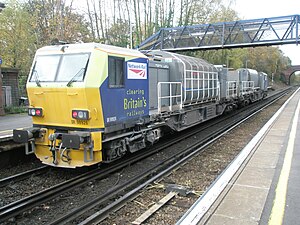British Rail MPV
| Railtrack Multi-Purpose Vehicle | |
|---|---|

DR98926 at Swanwick
|
|
| In service | 1999-present |
| Manufacturer | Windhoff |
| Built at | Münster |
| Family name | CargoSprinter |
| Constructed | 1998-2001, 2012 |
| Entered service | 1999-present |
| Number built |
|
| Formation | 1 or 2 cars |
| Operator(s) | Network Rail |
| Specifications | |
| Track gauge | 1,435 mm (4 ft 8 1⁄2 in) standard gauge |
The Multiple-purpose Vehicle or MPV is a purpose-built departmental derivative of a diesel multiple unit. Twenty-five two-car units were ordered by Railtrack to enable it to replace its varied collection of ageing departmental vehicles, many of which were converted from redundant passenger stock.
The vehicles were built in Germany by Windhoff. The design is based on the Windhoff "CargoSprinter" units that are operated by Deutsche Bahn (Germany) and CRT Group (Australia). Normally a unit consists of one powered vehicle fitted with twin 265 kW (355 hp) Railpac diesel engines, semi-permanently coupled to an unpowered slave unit without engines. The later orders for the South East of England and for overhead line replacement are instead composed of two powered units, to give better acceleration and top speed. When first built there were problems with the vehicles being 'out of gauge' when running empty.
The concept of the design is that each vehicle has a driving cab and an under floor engine/transmission with Multiple unit (MU) control. The majority of each vehicle is a flat load bed that can carry combinations of 10-foot and 20-foot modules that are secured using the locking system for ISO standard containers. Modules can be changed as required to suit current requirements.
The use of standard container mountings led to suggestions that "Freight Multiple Units" could be introduced. In 2005, two powered MPV units were used for freight trials by coupling standard freight wagons between in between the pairs. Temporary multiple unit control cables were run along the wagons in order to connect the two MPVs, which are acting as locomotives working as a push-pull train.
There are five distinct types of MPV unit that represent the development of the concept for use in the UK.
For the replacement of overhead lines on the West Coast Main Line at the start of the 2000s, Railtrack designed and ordered two new self-powered High Output Wiring Trains (HOWT). The order was placed with Windhoff in July 1999 and the first train available for trials in Germany in June 2000 before being shipped to the United Kingdom shortly afterwards. The replacement program using the new trains began in November 2000.
...
Wikipedia
